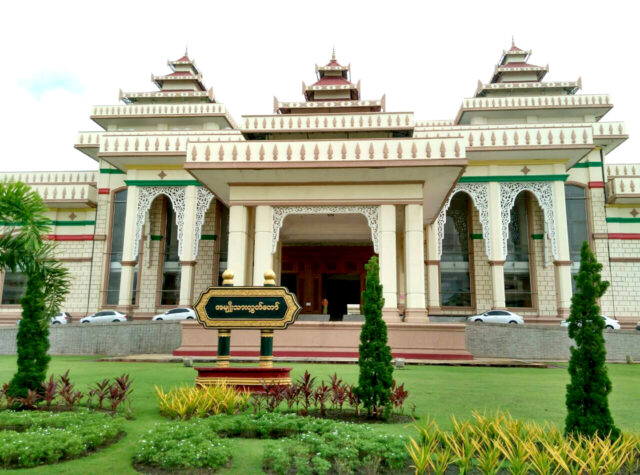Myanmar Conflict Implications for U.S. National Security

China’s engagement with the Myanmar (Burma) junta has offered the People’s Liberation Army Navy (PLAN) access to another port in the Bay of Bengal, on the Indian Ocean, threatening the national security of both the United States and India. To counter a rising China, the U.S. should revise its definition of the Indian Ocean area of responsibility, and formulate a plan dedicated specifically to the Bay of Bengal.
Additionally, military cooperation with India should be increased, while the Department of Defence should consider deploying an Indian Ocean Task Force, paying particular attention to the Bay of Bengal. Furthermore, tough sanctions should be taken against China to discourage their ongoing support of the military junta, as well as Beijing’s continued access to Myanmar ports.
Beijing’s 2019 Defense White Paper identified an expanded role for the People’s Liberation Army Navy (PLAN) in protecting China’s overseas interests. The Western Pacific, along with the Indian Ocean and the Bay of Bengal, is crucial to this objective.
The 2017 U.S. National Security Strategy defines the Indo-Pacific as the area stretching from “the west coast of India to the western shores of the United States.” This definition fails to prioritise the Bay of Bengal, which, as well as being bordered by India, is also bordered by Bangladesh, Myanmar, and Sri Lanka, countries where China is establishing a greater economic and military presence.
Regional Geopolitical Scenario
Following the Maritime Silk Road, the PLAN has deployed an aircraft carrier task group for exercises in the Western Pacific, led joint counterterrorism training in Sri Lanka, and conducted joint military patrols with Myanmar. A PLAN task group delivered disaster relief to Sri Lanka, while a warship and a submarine have docked there. Additionally Beijing sells weapons to Bangladesh, including submarines, and may establish a missile maintenance hub there.
Since the February 2021 coup in Myanmar, which ousted the elected government of Aung San Suu Kyi, the United States and other democracies have imposed sanctions on the new regime, leaving China as the junta’s largest supporter. Beijing provides economic help to the generals as natural resource purchases, as well as investment.
Among China-invested projects are oil and gas pipelines which avoid the U.S. Navy-patrolled Strait of Malacca. Most troubling for the U.S., however, is China’s investment in the Kyaukpyu Special Economic Zone and its deep-sea port in Myanmar’s Rakhine State, providing the PLAN with access to the Bay of Bengal.
China is actively cultivating smaller islands and littorals which it could militarise, as it has done in the South China Sea. China controls Sri Lanka’s Hambantota Port, which has raised concern in both New Delhi and Washington. Besides possible activity by the PLAN, China’s maritime militia poses a further security threat.
With Chinese control of multiple ports, the Bay of Bengal could become a staging ground for this clandestine paramilitary force. As essentially any civilian craft could be sworn into the maritime militia and equipped with listening devices or even weapons, estimates for the militia’s size run into thousands of boats, with hundreds deployed in the disputed Spratley Islands alone.
Washington needs to scrutinise Chinese activity in the region carefully, even though some of it comes under the guise of benign activities, such as protecting Chinese citizens and investments, or undertaking counterterrorism or anti-piracy operations. At the same time, however, PLAN ships, as well as merchant and fishing vessels, may also gather military intelligence.
All the while, Beijing is using economic coercion to draw smaller nations into the Chinese orbit. Through its investment in ports, telecommunications, and other infrastructure, China is establishing a network of dual-use capabilities which could become vital in the event of war. Establishing host-nation bases of operation are of particular importance for the PLA Air Force, which currently has no long-range warfare capability.
For New Delhi, the Indian Ocean represents a vital strategic theatre, essential for the country’s economic, diplomatic, military, and regional policy objectives, as well as India’s national security. India’s primary areas of interests include the northern Indian Ocean, encompassing the Arabian Sea, Bay of Bengal, and the Persian Gulf. Therefore, the Bay of Bengal is within India’s area of concern. According to the Pentagon, Beijing is likely to continue “developing the capabilities and operational concepts to conduct offensive operations deeper into the Pacific and Indian Ocean” — and India’s general necessity to contain China aligns with U.S. policy concerns.
Conclusion
India, as the largest and most powerful nation in the region, must play an expanded role in Washington’s Indian Ocean strategy. Annual engagements between both countries’ Maritime Security Coordinators could be added to the U.S.-India Maritime Security Dialogue.
An Indian Navy official could add to the U.S. Indo-Pacific Command (INDOPACOM ). Working through India, the United States. could increase its engagement with the seven island nations in the Indian Ocean, where the U.S. currently only has three embassies and two defence attaches. The Indian Coast Guard already provides services to many of these countries. The U.S. Coast Guard could partner with the Indian Coast Guard on joint patrols and in providing training for other nations.
If deployed, an Indian Ocean Task Force could inspect littorals and islands, seeking signs of Chinese militarisation. As the United States has limited resources, this work could be conducted through alliances based on existing frameworks. Development of an Indian Ocean regional grouping should be intensified, including augmenting the Indian Ocean Rim Association (IORA) and Indian Ocean Naval Symposium (IONS).
Additionally, African states should be integrated into the Indian Ocean and Indo-Pacific fora. Similarly, the U.S.-led Indo-Pacific Economic Framework for Prosperity could be expanded to include greater security cooperation. The same is true of the Indo-Pacific Business Forum, which is sponsored by the U.S. and Japan. Therefore, the Quad could be expanded to Quad Plus.
Author: Antonio Graceffo.
Disclaimer. The views and opinions expressed in this report are those of the author and do not necessarily reflect the official policy or position of SpecialEurasia.
